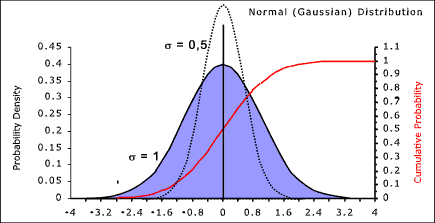Statistics Index
Continuous Probability Distributions
Normal Gaussian Distributions
Introduction.....
Symbols.....
Mean and Variance.....
Normal Distribution.....
Standardised normal table.....
Using normal table.....
Estimation of parameters.....
|
Introduction Probability distributions for continuous random variables differs from discrete distributions variables in the following important aspects:
1) A variable can take on any, of an infinite number of values within the range
In engineering as in most other disciplines it is useful to determine patterns
which indicate the probability of variables and events e.g in the mass production of 50mm diameter
shaft on a lathe... what is the probability of the shafts being within the acceptable tolerance limits . Probability curves show
the variable on the x axis and the probability f(x) of the variable on the y axis.
The total area under the curve represents the probability of all possible events and equals 1
1) The graphed distribution curve is bell shaped and is symmetrical about the mean value Symbols
Mean and variance of a continuous distribution The mean value of a distribution is denoted by μ and is defined by
The variance of a continuous distribution σ2 and is defined by
f(x) is the probability function of the random variable X under consideration.
The defintion of f(x) for a normal distribution is provided below. Normal (Gaussian) Probability Distribution
The probability that is a single trial the variable will assume a value ≤ x is called the distribution function
A typical normal probability curve drawn with a mean value μ= 0 and a variance σ 2 = 1 is shown above. For this case the probability that is a single trial the variable will assume a value ≤ x becomes
(This function is plotted on the webpage Standardised Normal Distribution Table:
Note:
This is clearly = Φ(z) where z = (x - μ ) / σ
It is very easy to obtain the probability that a variable x meets the criteria ( a < x < b ) using the tabled values by using the relationship.
Standardised Normal Probability Distribution Table Φ(z) Standardised Normal Distribution Table The webpage linked provides values for Φ(z) for the range z = 0 to 4,19 . Using the Standardised Normal Probability Distribution Table a) Determining the probability of value is between a = μ - σand setting b = μ + σ using the tables result in simply looking up the difference in values Φ (1) - Φ (-1) = 0.841345 - (1- 0.841345) = 0.68269 b) Determining the probability of value is between a = μ - 2σand setting b = μ + 2σ using the tables result in simply looking up the difference in values Φ (2) - Φ (-2) = 0.97725 - (1- 0.97725) = 0.9545 c) Determining the probability of value is between a = μ - 3σand setting b = μ + 3σ using the tables result in simply looking up the difference in values Φ (2) - Φ (-2) = 0.0.99865 - (1- 0.0.99865) = 0.9973 The above simple calculations show that if a population conforms to a normal probability distribution
The relationship applies to all normal distribution. Example using the tables.Determine the probability P( x ≤ 10,5 ) for a x is normal with a mean (μ) = 10 and a standard deviation (σ ) = 2.
There is a 60% probability of x being less than or equal to 10,5 Estimation of Normal Distribution Parameters The values of p in the binomial distribution and μ and σ are the called the parameters of the distributions and it is frequently necessary to obtain values for these parameters from a given sample of a population. It is often sufficient to obtain an estimate of μ ( xm is approximately equal to μ ) using the equation ref.Sample Variables
and it is possible to obtain an estimate of the variance ( as sx is approximately = to σ using the equation ref.Sample Variables
In the case of the binomial distribution the p is easily estimated as being approximately p = approximately xm / n For normal probability distributions good evaluations of the parameters
can be obtained using normal probability paper. This is graph paper with
the lines arranged such that a normal probability distribution is plotted as a straight line. |
Useful Related Links
|
|







